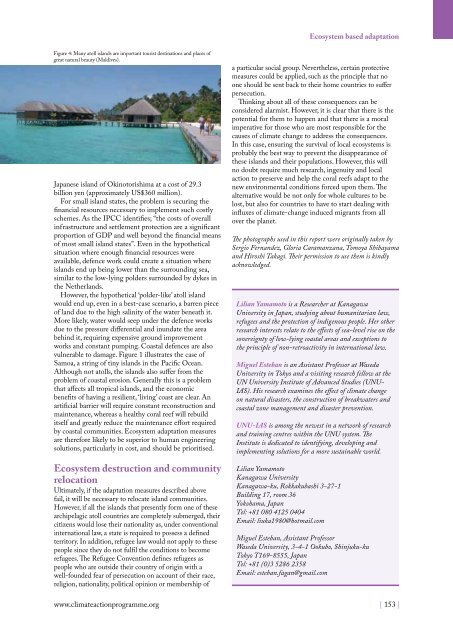Climate Action 2010-2011
You also want an ePaper? Increase the reach of your titles
YUMPU automatically turns print PDFs into web optimized ePapers that Google loves.
Ecosystem based adaptation<br />
Figure 4: Many atoll islands are important tourist destinations and places of<br />
great natural beauty (Maldives).<br />
Japanese island of Okinotorishima at a cost of 29.3<br />
billion yen (approximately US$360 million).<br />
For small island states, the problem is securing the<br />
financial resources necessary to implement such costly<br />
schemes. As the IPCC identifies; “the costs of overall<br />
infrastructure and settlement protection are a significant<br />
proportion of GDP and well beyond the financial means<br />
of most small island states”. Even in the hypothetical<br />
situation where enough financial resources were<br />
available, defence work could create a situation where<br />
islands end up being lower than the surrounding sea,<br />
similar to the low-lying polders surrounded by dykes in<br />
the Netherlands.<br />
However, the hypothetical ‘polder-like’ atoll island<br />
would end up, even in a best-case scenario, a barren piece<br />
of land due to the high salinity of the water beneath it.<br />
More likely, water would seep under the defence works<br />
due to the pressure differential and inundate the area<br />
behind it, requiring expensive ground improvement<br />
works and constant pumping. Coastal defences are also<br />
vulnerable to damage. Figure 1 illustrates the case of<br />
Samoa, a string of tiny islands in the Pacific Ocean.<br />
Although not atolls, the islands also suffer from the<br />
problem of coastal erosion. Generally this is a problem<br />
that affects all tropical islands, and the economic<br />
benefits of having a resilient, ‘living’ coast are clear. An<br />
artificial barrier will require constant reconstruction and<br />
maintenance, whereas a healthy coral reef will rebuild<br />
itself and greatly reduce the maintenance effort required<br />
by coastal communities. Ecosystem adaptation measures<br />
are therefore likely to be superior to human engineering<br />
solutions, particularly in cost, and should be prioritised.<br />
Ecosystem destruction and community<br />
relocation<br />
Ultimately, if the adaptation measures described above<br />
fail, it will be necessary to relocate island communities.<br />
However, if all the islands that presently form one of these<br />
archipelagic atoll countries are completely submerged, their<br />
citizens would lose their nationality as, under conventional<br />
international law, a state is required to possess a defined<br />
territory. In addition, refugee law would not apply to these<br />
people since they do not fulfil the conditions to become<br />
refugees. The Refugee Convention defines refugees as<br />
people who are outside their country of origin with a<br />
well-founded fear of persecution on account of their race,<br />
religion, nationality, political opinion or membership of<br />
a particular social group. Nevertheless, certain protective<br />
measures could be applied, such as the principle that no<br />
one should be sent back to their home countries to suffer<br />
persecution.<br />
Thinking about all of these consequences can be<br />
considered alarmist. However, it is clear that there is the<br />
potential for them to happen and that there is a moral<br />
imperative for those who are most responsible for the<br />
causes of climate change to address the consequences.<br />
In this case, ensuring the survival of local ecosystems is<br />
probably the best way to prevent the disappearance of<br />
these islands and their populations. However, this will<br />
no doubt require much research, ingenuity and local<br />
action to preserve and help the coral reefs adapt to the<br />
new environmental conditions forced upon them. The<br />
alternative would be not only for whole cultures to be<br />
lost, but also for countries to have to start dealing with<br />
influxes of climate-change induced migrants from all<br />
over the planet.<br />
The photographs used in this report were originally taken by<br />
Sergio Fernandez, Gloria Caramanzana, Tomoya Shibayama<br />
and Hiroshi Takagi. Their permission to use them is kindly<br />
acknowledged.<br />
Lilian Yamamoto is a Researcher at Kanagawa<br />
University in Japan, studying about humanitarian law,<br />
refugees and the protection of indigenous people. Her other<br />
research interests relate to the effects of sea-level rise on the<br />
sovereignty of low-lying coastal areas and exceptions to<br />
the principle of non-retroactivity in international law.<br />
Miguel Esteban is an Assistant Professor at Waseda<br />
University in Tokyo and a visiting research fellow at the<br />
UN University Institute of Advanced Studies (UNU-<br />
IAS). His research examines the effect of climate change<br />
on natural disasters, the construction of breakwaters and<br />
coastal zone management and disaster prevention.<br />
UNU-IAS is among the newest in a network of research<br />
and training centres within the UNU system. The<br />
Institute is dedicated to identifying, developing and<br />
implementing solutions for a more sustainable world.<br />
Lilian Yamamoto<br />
Kanagawa University<br />
Kanagawa-ku, Rokkakubashi 3-27-1<br />
Building 17, room 36<br />
Yokohama, Japan<br />
Tel: +81 080 4125 0404<br />
Email: liuka1980@hotmail.com<br />
Miguel Esteban, Assistant Professor<br />
Waseda University, 3-4-1 Ookubo, Shinjuku-ku<br />
Tokyo T169-8555, Japan<br />
Tel: +81 (0)3 5286 2358<br />
Email: esteban.fagan@gmail.com<br />
www.climateactionprogramme.org | 153 |












